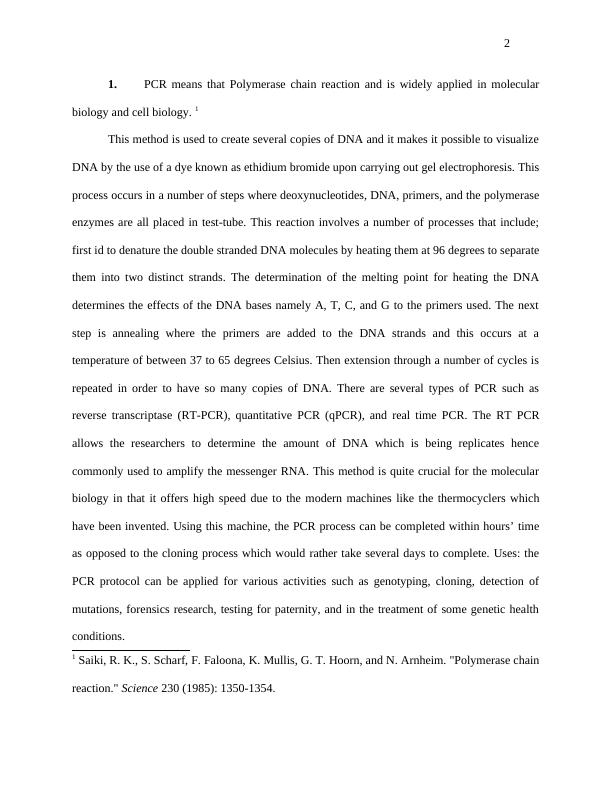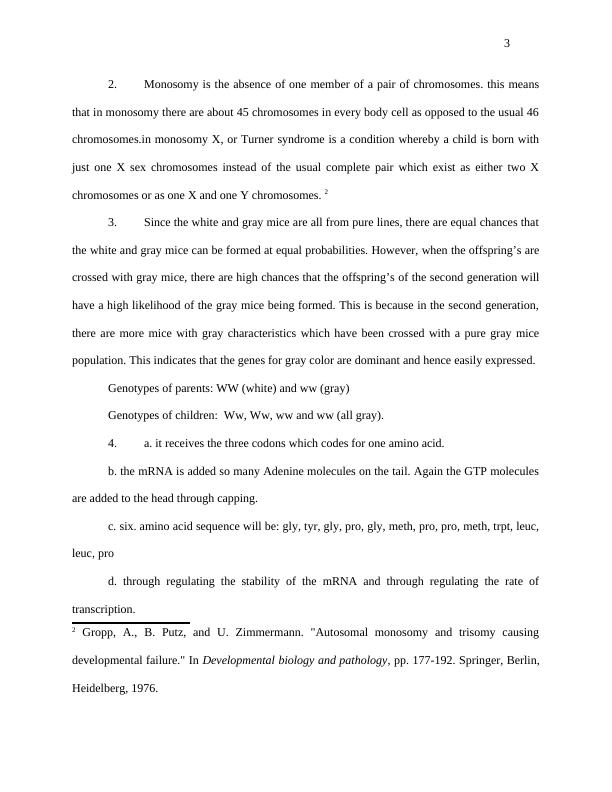PCR, Monosomy, Genes and RNA: A Molecular Biology Overview
Added on 2023-06-13
10 Pages2834 Words155 Views
Running head: 1
Name
Date of Submission
Name
Date of Submission

2
1. PCR means that Polymerase chain reaction and is widely applied in molecular
biology and cell biology. 1
This method is used to create several copies of DNA and it makes it possible to visualize
DNA by the use of a dye known as ethidium bromide upon carrying out gel electrophoresis. This
process occurs in a number of steps where deoxynucleotides, DNA, primers, and the polymerase
enzymes are all placed in test-tube. This reaction involves a number of processes that include;
first id to denature the double stranded DNA molecules by heating them at 96 degrees to separate
them into two distinct strands. The determination of the melting point for heating the DNA
determines the effects of the DNA bases namely A, T, C, and G to the primers used. The next
step is annealing where the primers are added to the DNA strands and this occurs at a
temperature of between 37 to 65 degrees Celsius. Then extension through a number of cycles is
repeated in order to have so many copies of DNA. There are several types of PCR such as
reverse transcriptase (RT-PCR), quantitative PCR (qPCR), and real time PCR. The RT PCR
allows the researchers to determine the amount of DNA which is being replicates hence
commonly used to amplify the messenger RNA. This method is quite crucial for the molecular
biology in that it offers high speed due to the modern machines like the thermocyclers which
have been invented. Using this machine, the PCR process can be completed within hours’ time
as opposed to the cloning process which would rather take several days to complete. Uses: the
PCR protocol can be applied for various activities such as genotyping, cloning, detection of
mutations, forensics research, testing for paternity, and in the treatment of some genetic health
conditions.
1 Saiki, R. K., S. Scharf, F. Faloona, K. Mullis, G. T. Hoorn, and N. Arnheim. "Polymerase chain
reaction." Science 230 (1985): 1350-1354.
1. PCR means that Polymerase chain reaction and is widely applied in molecular
biology and cell biology. 1
This method is used to create several copies of DNA and it makes it possible to visualize
DNA by the use of a dye known as ethidium bromide upon carrying out gel electrophoresis. This
process occurs in a number of steps where deoxynucleotides, DNA, primers, and the polymerase
enzymes are all placed in test-tube. This reaction involves a number of processes that include;
first id to denature the double stranded DNA molecules by heating them at 96 degrees to separate
them into two distinct strands. The determination of the melting point for heating the DNA
determines the effects of the DNA bases namely A, T, C, and G to the primers used. The next
step is annealing where the primers are added to the DNA strands and this occurs at a
temperature of between 37 to 65 degrees Celsius. Then extension through a number of cycles is
repeated in order to have so many copies of DNA. There are several types of PCR such as
reverse transcriptase (RT-PCR), quantitative PCR (qPCR), and real time PCR. The RT PCR
allows the researchers to determine the amount of DNA which is being replicates hence
commonly used to amplify the messenger RNA. This method is quite crucial for the molecular
biology in that it offers high speed due to the modern machines like the thermocyclers which
have been invented. Using this machine, the PCR process can be completed within hours’ time
as opposed to the cloning process which would rather take several days to complete. Uses: the
PCR protocol can be applied for various activities such as genotyping, cloning, detection of
mutations, forensics research, testing for paternity, and in the treatment of some genetic health
conditions.
1 Saiki, R. K., S. Scharf, F. Faloona, K. Mullis, G. T. Hoorn, and N. Arnheim. "Polymerase chain
reaction." Science 230 (1985): 1350-1354.

3
2. Monosomy is the absence of one member of a pair of chromosomes. this means
that in monosomy there are about 45 chromosomes in every body cell as opposed to the usual 46
chromosomes.in monosomy X, or Turner syndrome is a condition whereby a child is born with
just one X sex chromosomes instead of the usual complete pair which exist as either two X
chromosomes or as one X and one Y chromosomes. 2
3. Since the white and gray mice are all from pure lines, there are equal chances that
the white and gray mice can be formed at equal probabilities. However, when the offspring’s are
crossed with gray mice, there are high chances that the offspring’s of the second generation will
have a high likelihood of the gray mice being formed. This is because in the second generation,
there are more mice with gray characteristics which have been crossed with a pure gray mice
population. This indicates that the genes for gray color are dominant and hence easily expressed.
Genotypes of parents: WW (white) and ww (gray)
Genotypes of children: Ww, Ww, ww and ww (all gray).
4. a. it receives the three codons which codes for one amino acid.
b. the mRNA is added so many Adenine molecules on the tail. Again the GTP molecules
are added to the head through capping.
c. six. amino acid sequence will be: gly, tyr, gly, pro, gly, meth, pro, pro, meth, trpt, leuc,
leuc, pro
d. through regulating the stability of the mRNA and through regulating the rate of
transcription.
2 Gropp, A., B. Putz, and U. Zimmermann. "Autosomal monosomy and trisomy causing
developmental failure." In Developmental biology and pathology, pp. 177-192. Springer, Berlin,
Heidelberg, 1976.
2. Monosomy is the absence of one member of a pair of chromosomes. this means
that in monosomy there are about 45 chromosomes in every body cell as opposed to the usual 46
chromosomes.in monosomy X, or Turner syndrome is a condition whereby a child is born with
just one X sex chromosomes instead of the usual complete pair which exist as either two X
chromosomes or as one X and one Y chromosomes. 2
3. Since the white and gray mice are all from pure lines, there are equal chances that
the white and gray mice can be formed at equal probabilities. However, when the offspring’s are
crossed with gray mice, there are high chances that the offspring’s of the second generation will
have a high likelihood of the gray mice being formed. This is because in the second generation,
there are more mice with gray characteristics which have been crossed with a pure gray mice
population. This indicates that the genes for gray color are dominant and hence easily expressed.
Genotypes of parents: WW (white) and ww (gray)
Genotypes of children: Ww, Ww, ww and ww (all gray).
4. a. it receives the three codons which codes for one amino acid.
b. the mRNA is added so many Adenine molecules on the tail. Again the GTP molecules
are added to the head through capping.
c. six. amino acid sequence will be: gly, tyr, gly, pro, gly, meth, pro, pro, meth, trpt, leuc,
leuc, pro
d. through regulating the stability of the mRNA and through regulating the rate of
transcription.
2 Gropp, A., B. Putz, and U. Zimmermann. "Autosomal monosomy and trisomy causing
developmental failure." In Developmental biology and pathology, pp. 177-192. Springer, Berlin,
Heidelberg, 1976.

End of preview
Want to access all the pages? Upload your documents or become a member.